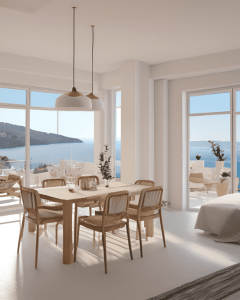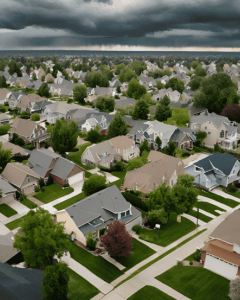US New Homes: The Shocking Truth about Rising Buying Costs and Shrinkage
In the face of rising housing costs, builders have found a way to adapt: constructing smaller homes. The median square footage for a home under construction has reached its lowest point since 2010, with the current average size being 2,191 square feet, according to data from the U.S. Census Bureau.
In the face of rising housing costs, builders have found a way to adapt: constructing smaller homes. The median square footage for a home under construction has reached its lowest point since 2010, with the current average size being 2,191 square feet, according to data from the U.S. Census Bureau. This represents a decrease of nearly 3% compared to the first quarter of this year and a significant drop of over 6% since the end of 2021, which marked the peak in home size over the past five years.

Experts suggest that the shift towards smaller homes is an attempt to address the challenges posed by housing affordability. Robert Dietz, the chief economist at the National Association of Home Builders, explains that the size of homes being built initially increased at the start of the pandemic due to low mortgage rates and the need for dedicated workspaces within homes. However, with mortgage rates on the rise, Dietz predicts that the median and average square footage will continue to decline.
As of August 21, the survey for 30-year fixed mortgage rates from Mortgage News Daily reached an alarming 7.48%, the highest level in more than 20 years. Coupled with the fact that home prices remain high in most markets, affordability has plummeted to near all-time lows. The Wells Fargo/NAHB Housing Opportunity Index, which measures affordability, stood at 40.5% at the end of June, slightly better than the all-time low of 38.1% recorded at the close of 2022.
Despite these daunting affordability figures, there is still a demand for new homes, potentially due to their smaller and more affordable nature. Affordability seems to be a driving factor when it comes to the size of homes being built. Prior to the past year, the trend over the past 25 years was to construct larger single-family homes. However, following the Great Recession, the market share of entry-level new construction declined while home size increased from 2009 to 2015. The subsequent years saw a reversal of this trend as the focus shifted towards developing more starter homes, resulting in a decline in average home size between 2016 and 2020.
It is worth noting that home size varies by region. In the Northeast, the median square footage for a home under construction in the second quarter was 2,410, while in the Midwest it was only 1,979 square feet. The South region had homes under construction with a median size of 2,248 square feet, whereas the West came in at 2,135 square feet.
In conclusion, the homebuilding industry is adapting to the challenges posed by soaring housing costs by constructing smaller and more affordable homes. The decline in median square footage for homes under construction reflects the urgent need to address housing affordability concerns. While mortgage rates continue to rise, it is expected that the size of newly constructed homes will continue to shrink. Despite these challenges, the demand for new homes remains strong, with affordability playing a significant role in consumer preferences.
US New Homes: The Shocking Truth about Rising Buying Costs and Shrinkage
Greece Real Estate Market: Rise of Serviced Apartments
Explore the growing demand for serviced apartments in central Athens, where integrated hospitality services attract savvy investors in the Greece real estate market.
Explore the growing demand for serviced apartments in central Athens, where integrated hospitality services attract savvy investors in the Greece real estate market.
Read moreHome Prices Hit by Climate Change, J.P. Morgan Warns
J.P. Morgan analysts reveal a negative link between climate risk and home price appreciation. Explore the emerging trends and their impact.
J.P. Morgan analysts reveal a negative link between climate risk and home price appreciation. Explore the emerging trends and their impact.
Read moreRenting in Spain: Prices Finally Decline
The cost of renting in Spain trends downwards, averaging €13/m². Discover insights on this shift after years of steep increases.
The cost of renting in Spain trends downwards, averaging €13/m². Discover insights on this shift after years of steep increases.
Read moreRise of Cash Purchases Outside London: A New Trend
Explore the growing trend of cash purchases outside London and its implications for the property market and economic landscape.
Explore the growing trend of cash purchases outside London and its implications for the property market and economic landscape.
Read moreCanada Real Estate Market: Rents Drop for First Time in over 3 years
For the first time in over three years, average asking rents in Canada fell 1.2% in October, reaching $2,152, according to Rentals.ca.
For the first time in over three years, average asking rents in Canada fell 1.2% in October, reaching $2,152, according to Rentals.ca.
Read moreFewer Than 2% of Dutch Homes Sold to International Buyers
Analyze the decline in international purchases of Dutch houses, revealing key factors influencing this trend and its effects on the housing market.
Analyze the decline in international purchases of Dutch houses, revealing key factors influencing this trend and its effects on the housing market.
Read moreDonald Trump’s Victory May Boost London Property Demand
Knight Frank analyzes how Donald Trump’s election win could increase demand for prime London properties. Discover the potential market shifts.
Knight Frank analyzes how Donald Trump’s election win could increase demand for prime London properties. Discover the potential market shifts.
Read moreGerman Investors Fuel Growth in Greek Real Estate Market
Discover how German-speaking house buyers are revitalizing Greece's realty market, driving demand and investment in stunning properties.
Discover how German-speaking house buyers are revitalizing Greece\'s realty market, driving demand and investment in stunning properties.
Read moreLisbon: 11th City for Rising Luxury House Prices
Lisbon's luxury housing prices increased by 5.6%, outpacing Madrid, Seoul, and Zurich, marking it as a key player in the global real estate market.
Lisbon\'s luxury housing prices increased by 5.6%, outpacing Madrid, Seoul, and Zurich, marking it as a key player in the global real estate market.
Read more













